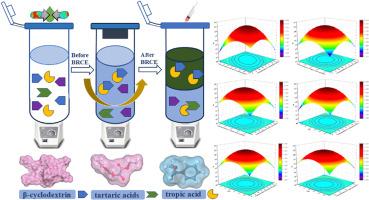Enantioseparation of tropic acid by biphasic enantioselective liquid-liquid extraction: Experimental and simulation
IF 6
2区 化学
Q1 CHEMISTRY, ANALYTICAL
引用次数: 0
Abstract
Background
Nowadays, accessing optically-pure compounds from chiral drugs on a large scale in an eco-friendly and cost-effective manner remains one of the greatest challenges. Racemic separation is still the most effective approaches. And meanwhile, as one of the methods, biphasic recognition chiral extraction (BRCE) strategy, is widely recognized as a highly promising technique for industrial implementation due to its advantages of high efficiency, broad versatility, and facile scalability. The configuration of BRCE facilitates capacity expansion to multi-kilogram production scales, unconstrained by the bed-height limitations inherent to fixed-bed chromatographic systems. (88)Results
Herein we first present, employing hydrophilic β-cyclodextrin and hydrophobic tartaric acids as the collaborative chiral additives for BRCE process to improve the efficiency of enantio-separation tropic acid mixture. The screening of chiral additives and organic solvents for BRCE framework were systematically investigated, along with the developed system was used to optimize experimental conditions in depth, including concentration of tropic acid and chiral additives, aqueous pH, and operational temperature, using response surface methodology (RSM) method. The maximum enantioselectivity (α) and enantiomeric excess (e.e.%) up to 2.28 and 12.3% were achieved by the BRCE system which is more-efficient than previous extraction systems. The principle of BRCE strategy mainly refers to the host-guest stereoselective affinity and phase transfer, forming labile diastereoisomeric complexes with the assistance of the density functional theory (DFT) method. (127)Significance
The enhanced performance is attributed to the simultaneous biphasic recognition of both R- and S-tropic acid. This study provides critical insights for developing enhanced BRCE systems tailored to specific enantio-separation applications. Furthermore, the differing stereochemical preferences under thermodynamic and kinetic conditions could be strategically leveraged to further enhance enantio-separation efficiency through sequential BRCE framework. (55)

双相对映选择液-液萃取法分离热带酸的对映体:实验与模拟
目前,从手性药物中大规模获取光纯化合物,以一种环保和经济的方式仍然是最大的挑战之一。外消旋分离仍然是最有效的方法。同时,双相识别手性提取(BRCE)策略作为其中一种方法,由于其效率高、通用性广、易于扩展等优点,被广泛认为是一种极具工业应用前景的技术。BRCE的配置有利于产能扩展到多公斤的生产规模,不受固定床色谱系统固有的床高限制。(88)结果首次采用亲水性β-环糊精和疏水性酒石酸作为BRCE工艺的手性协同添加剂,提高了对映体分离的效率。系统研究了BRCE骨架的手性添加剂和有机溶剂的筛选,并利用响应面法(RSM)对实验条件进行了深入优化,包括热带酸和手性添加剂的浓度、水溶液pH和操作温度。BRCE体系的对映体选择性(α)和对映体过量(e.e.%)分别达到2.28%和12.3%,比以往的萃取体系效率更高。BRCE策略的原理主要是指主客体立体选择性亲和和相转移,借助密度泛函理论(DFT)方法形成不稳定的非对映异构体配合物。(127)性能的增强是由于同时双相识别R-和S-tropic acid。该研究为开发针对特定对映体分离应用的增强型BRCE系统提供了关键见解。此外,在热力学和动力学条件下,不同的立体化学偏好可以通过顺序BRCE框架进一步提高对映体分离效率。(55)
本文章由计算机程序翻译,如有差异,请以英文原文为准。
求助全文
约1分钟内获得全文
求助全文
来源期刊

Analytica Chimica Acta
化学-分析化学
CiteScore
10.40
自引率
6.50%
发文量
1081
审稿时长
38 days
期刊介绍:
Analytica Chimica Acta has an open access mirror journal Analytica Chimica Acta: X, sharing the same aims and scope, editorial team, submission system and rigorous peer review.
Analytica Chimica Acta provides a forum for the rapid publication of original research, and critical, comprehensive reviews dealing with all aspects of fundamental and applied modern analytical chemistry. The journal welcomes the submission of research papers which report studies concerning the development of new and significant analytical methodologies. In determining the suitability of submitted articles for publication, particular scrutiny will be placed on the degree of novelty and impact of the research and the extent to which it adds to the existing body of knowledge in analytical chemistry.
 求助内容:
求助内容: 应助结果提醒方式:
应助结果提醒方式:


